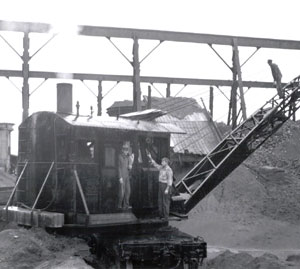
Phosphate Mining and Industry
In 1886 William Shirley, a stonecutter, discovered phosphate on Gholston Hill near Columbia. This deposit proved to be too limited to be mined economically. In 1891 Shirley found a stratified blue rock deposit around Knob Creek, north of Columbia. A small group organized the Tennessee Phosphate Company, and the following year two tons of phosphate were shipped to National Fertilizer Company in Nashville. The company also mined blue rock phosphate at Swan Creek and Gordonsburg, both in Lewis County, and the Swan Bluff area in Hickman County.
In 1896 Judge S. O. Weatherly discovered brown rock near Mt. Pleasant. This site contained brown phosphate rock of high grade and proved to be one of the most important mineral discoveries in Tennessee. As news of this find spread, mining and industry moved into the area. Mt. Pleasant became a boomtown with the population increasing from 466 in 1890 to 2,000 in 1900, and fifteen companies were in operation in the early 1900s. Small companies were bought or forced out by larger companies.
Companies operating fertilizer plants in the area were Charleston Mining Company, owned by Virginia-Carolina Chemical Company; Federal Chemical Company; International Minerals and Chemical Corporation, operating in Maury and Giles counties; Hoover and Mason Phosphate Company; Ruhm Phosphate Company; and Armour Fertilizer Works. Rockdale Furnace, located south of Mt. Pleasant, manufactured ferrophosphate steel by a process of mixing phosphate and iron. This material was used for armor plating for artillery guns and battleships in World War I. The production of brown rock became the main source of supply of Tennessee phosphate. At first, all mining operations were done by hand using picks and ten-tined stone forks; ore was hauled by mule-drawn wagons. Labor was plentiful at 65 cents a day; the teams went at $1.50 per day.
According to a fiftieth anniversary company history developed by the Columbia branch of Monsanto, the initial mines typically yielded “plate rock,” which was 14.5 percent phosphorus, and by 1923 most of this had been mined. Companies then had to devise washing methods that could concentrate lower grade rock and make it usable. After building washing installations, companies found that they could use rock, or “muck,” with as little as 8 percent phosphorus, allowing them to “re-mine” some areas as many as three or four times.
In the 1930s the Tennessee Valley Authority (TVA) began research on the production of phosphate fertilizers by electric furnace process. The TVA’s electric furnaces were at Muscle Shoals, Alabama. A mining and washing division was built in Columbia. In 1936 Monsanto Chemical began construction of a plant near Columbia for the manufacture of elemental phosphorus. Victor Chemical Works located in Mt. Pleasant the following year. This company later sold to Stauffer Chemical Company. Shea Chemical built an electric furnace operation in Columbia in 1951. This plant became Hooker Chemical Company, then Occidental Chemical Corporation. A 1971 study of the phosphate industry in Maury County reported that the three phosphorus producing plants had an annual payroll of $15 million. An additional $60 million to $70 million were put into the local economy that year in the purchasing of raw materials and in the operating and maintaining of material and supplies.
Increased operational costs, a decline in the market for phosphate materials (primarily in the manufacture of detergents), and the depletion of phosphate reserves were factors that ended the phosphate industry in this area. Mobil Chemical Company, which had purchased the Virginia-Carolina plant in Mt. Pleasant, shut down its phosphorus furnace in 1971. Monsanto Chemical Company began its shut down in 1986. Rhone-Poulenc, owner of the former Stauffer Company, and Occidental Chemical Corporation ceased operations in 1991.
For one hundred years the phosphate industry played a vital role in the economic growth and material prosperity of Maury County. Its history is interpreted at the Mt. Pleasant/Maury Phosphate Museum in Mt. Pleasant.
Suggested Reading
William B. Bruce, History of Maury County, Tennessee (1955); Monsanto, The Fiftieth Anniversary of the Columbia Plant (1986); Columbia Daily Herald, 2 July 2 1976



